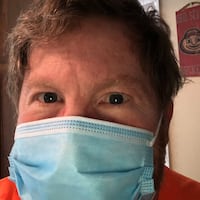Suicide in 2017 was the leading cause of death for Ohioans ages 10-14, and 2nd highest cause for ages 12-18 (middle and high school), behind only accidental injuries. Suicide also was 2nd highest for ages 18-22.
Suicide rates also are high for middle-aged white men, with rates climbing for middle-aged Black men, said Kristina Latta Landefeld, of Envision Partnerships, which works to promote mental health and healthy lifestyles.
In 2019, also before increased stress from the COVID-19 pandemic that isolated people from friends and classmates, significant percentages of Ohio youth who were surveyed revealed suicidal thoughts:
- Almost 1 out of 6 (15.6 percent) of middle- and high school students surveyed said they had seriously considered suicide in the past 12 months.
- Some 10.6 percent said they had made a plan to do so.
- More than 1 in 15 — 6.8 percent — said they attempted suicide in the prior 12 months.
- Also, 33 percent said they had felt hopelessness and sadness for a constant period of two weeks or more during the past 12 months.
September is National Suicide Prevention Month, and on Thursday, which is World Suicide Prevention Day, the 2nd annual Walk to Remember will happen at 6 p.m. at Pyramid Hill Sculpture Park. Anyone touched in any way by suicide — even knowing someone who attempted it — is welcome at the free event, although registration is requested through www.envisionpartnerships.com/walk2remember so organizers know how many to expect. One speaker will be a Hamilton High School student who survived suicide.
Kristen Riekert, a clinical social worker and therapist who is a sole practitioner in Mason, said, “in the beginning, I think all the therapists were sitting around, sort of waiting, like, ’OK, where are the people?’ Lots of us were brushing up on our marriage therapy skills.”
“It took a couple months,” she said. “But now, as it has dragged on, each week for the past four weeks I have seen more client.”
“By now, six months into this thing, it’s going to be a pretty rare person that’s not experiencing a lot of anxiety, some depression,” she said. Many people have vague senses that something’s wrong, but can’t say exactly what.
“So I’ve started talking about this blanket that’s lying on top of us, and its name is COVID, and everything you do is under it,” Riekert said.
“Our teens are isolated in a period of time in which their development says, ’Be with your friends, find your identity amongst your friends,’ Riekert said. “Your whole job during adolescence is to develop who you are, and you do that through the context of your family, but you also do that through what your friends are doing.”
“That isolation has been brutal,” she said. “It’s put kids in families that may not have been functioning all that terribly, but now are under stressed, and Dad’s lost his job, and maybe the wheels are coming off. And they don’t know where to go to get a break from that.”
Often, it’s teachers, or school nurses, who have kept people from attempting suicide in the past, but with many students learning remotely, those people are harder to speak with. And young people trying to reach out socially are exposing themselves in some cases to more toxic incidents on social media.
Getting or giving help
The Jason Foundation, based in Tennessee, is dedicated to curtailing the “silent epidemic of youth suicide,” fears the next time youth are surveyed about suicide thoughts and attempts, the results will be higher, because, “with kids not being able to go to school, not seeing their friends, all sorts of things like that, we believe the statistics are going to go through the roof.”
The organization’s website, jasonfoundation.com, offers advice for students, parents and those who work with youth about how to combat suicide.
Here’s some advice from them and others:
- It’s important to talk with others about how you’re feeling, and for everyone to be watchful for those who are struggling during this difficult. Teens should consider speaking with a parent, older sibling, minister, teacher or other trusted adult. “Everybody is experiencing this. It’s not a thing we need to cover up. We should probably all be more transparent about how we’re not doing very well,” Riekert said.
- See a doctor, or a therapist.
- People considering suicide, or wanting help fighting any type of drug or alcohol addiction, can call the Butler County Crisis and Heroin Hope Line at 844-427-4747.
- Prevention advocates recommend everybody should QPR, which is like CPR, but for suicide. QPR stands for Question, Persuade, Refer. People learn to Question others about whether they have suicidal thoughts, Persuade them to get professional help, and Refer them to such help. Much like CPR, there are life-saving techniques to that can be learned in 90 minutes. Training can be arranged by calling Kristen Smith at 513-407-2028 or ksmith@envisionpartnerships.com.
- Upcoming QPR Zoom meetings are scheduled for 10 a.m. Sept. 16; 9 a.m. Sept. 22; 10 a.m. Sept. 23; 12:30 p.m. Sept. 24; and 10 a.m. Sept. 30. Contact Kristen Smith using the information above for more information.
About the Author
